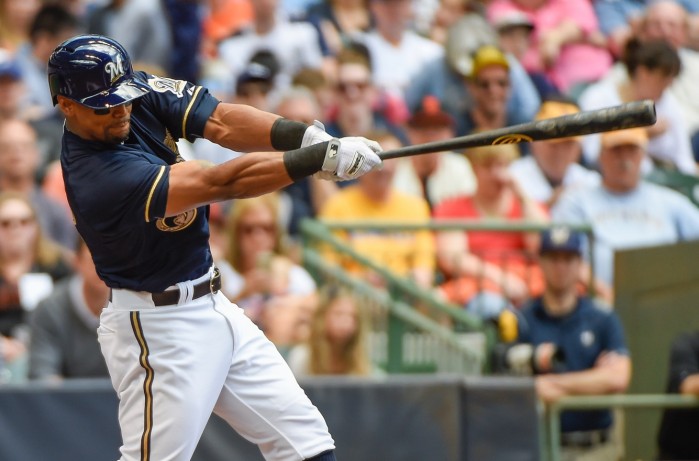Khris Davis has missed much of this season due to a torn meniscus. He’s currently in the middle of a rehab stint with the Wisconsin Timber Rattlers and is set to make his return to the active roster sometime this week. In his stead, Gerardo Parra has been enjoying a career season offensively and is one of the Brewers most valuable (and most likely to be dealt) trade chips. For that reason, it makes a lot sense to want to play him over Davis. However, I see a lot of people who simply think Khris Davis isn’t good enough to be a major-leaguer. That couldn’t be further from the truth.
I think most of the criticism Davis receives is due to an incomplete analysis of the player. People regularly criticize his arm. Indeed, it is arguably the worst outfield throwing arm in baseball. However, that’s just one aspect of his defense, which is only half of what a player brings to the table in the field.
He doesn’t have plus-speed, but he takes good routes. As a result, he’s been consistently able to make the routine plays. I’ve even seen him make some of the tough plays. Add in his weak arm, and it’s still not a great defensive profile. I wouldn’t even go so far as to call it a good profile. But it’s not nearly as bad as it seems many people believe.
By DRS (Defensive Runs Saved), he was a negative defender in 2013 (-2 DRS in 265 innings), a positive defender in 2014 (+5 in 1156.1 innings), and a negative defender this year (-4 in 344.1 innings). UZR mirrors that assessment: -3.1 UZR in 2013, +3.1 in 2014, and -0.7 this year. Defensive statistics are a work in progress and they can fluctuate from year to year. So if you take the long view here it’s probably best to call Khris Davis a below average to average defender in left. You could reasonably argue he’s squarely just below average.
Obviously that isn’t good, but there are worse fielders. Between 2013 and 2015, Khris Davis ranks 9th out of 15 in DRS among left fielders (min 1500 innings). That’s ahead of players like Matt Holliday, Justin Upton, and Melky Cabrera. His ranking by UZR is 10th. Among regulars with similar playing time in left, he ranks near the middle.
Thus, his defense is arguably better than it is publicly perceived. As stated above, though, his defensive value merely presents half the story. What about his bat? Unlike his defense, his offense has been above average in just about every way.
In 2013 (153 PA), he hit .279/.353/.596 with a .322 TAv (.260 TAv is considered league-average). Last year (549 PA), he compiled a .244/.299/.457 slash line with a .283 TAv. This year (169 PA), he’s hitting .250/.333/.446 with a .268 TAv. In every season (even last year with his poor .299 OBP), he’s been slightly-to-moderately above average offensively, thanks to his power production in a depressed run-scoring environment.
Although his injury has left us unable to put his production this season into its proper context, he appeared to be on the verge of a breakthrough of sorts. In 2013, he had a 7.2 percent walk rate. Last year, his walk rate declined to 5.8 percent. This year, he seemed to vastly improve in that area, as it jumped to 11.3 percent. That lines up nicely with his minor league walk rates, too. In all but two instances in the minors, he had double-digit walk rates. Those would be a 7.1 percent walk rate in 126 PA during his first trip to Double-A (the jump from High-A to Double-A is often considered the most difficult in the minors) and 9.1 percent in 22 PA during a rehab stint with the AZL Brewers, which hardly counts.
If Khris Davis really was translating his minor-league walk rates to the majors, he could have been — and hopefully still could be — on the path to becoming an above-average outfield bat in the major leagues. After all, his power numbers have ranked among the league leaders. He didn’t have many plate appearances in either 2013 or 2015, making it hard to properly compare his ISO and SLG in those years, but in 2014 his ISO (.214) ranked 15th in all of baseball and his slugging percentage (.457) ranked 34th. If you look at all players between 2013-2015 (min. 850 PA), he ranks 14th in ISO (.228) and 26th in SLG (.479).
If you limit these numbers to just left fielders, Khris Davis compares very favorably. Between 2013-2015 (min. 850 innings), he ranks second (to Bryce Harper) in ISO and fourth (after Harper, JD Martinez, and Carlos Gonzalez) in slugging.
In his only full season (2014), he ranked 61st in baseball by TAv. That’s also 26th among outfielders. He ranked 76th in WARP (2.76). That makes him 31st among outfielders. He had a 5.8 percent walk rate and a .299 OBP that year. Imagine what his offense would look like if he could pair his power numbers with a solid OBP, stemming from a strong walk rate — which he began to show this year.
Khris Davis gets too much criticism for his poor defense. It is definitely not a strength, but it’s just poor and not a massive liability. It’s also not all there is to him. His offense is a strength. Add it all together, and he has at least been an average regular. If his improved walk rate is real and can be sustained, he has a chance to be better than average. Of course, Davis is 27 years old, so it’s not likely he keeps improving, but he could have several prime years left. That’s a perfect player to have during a rebuild, as he likely isn’t an extension candidate but could develop strong trade value.

2 comments on “Don’t Judge Khris Davis For What He Isn’t”